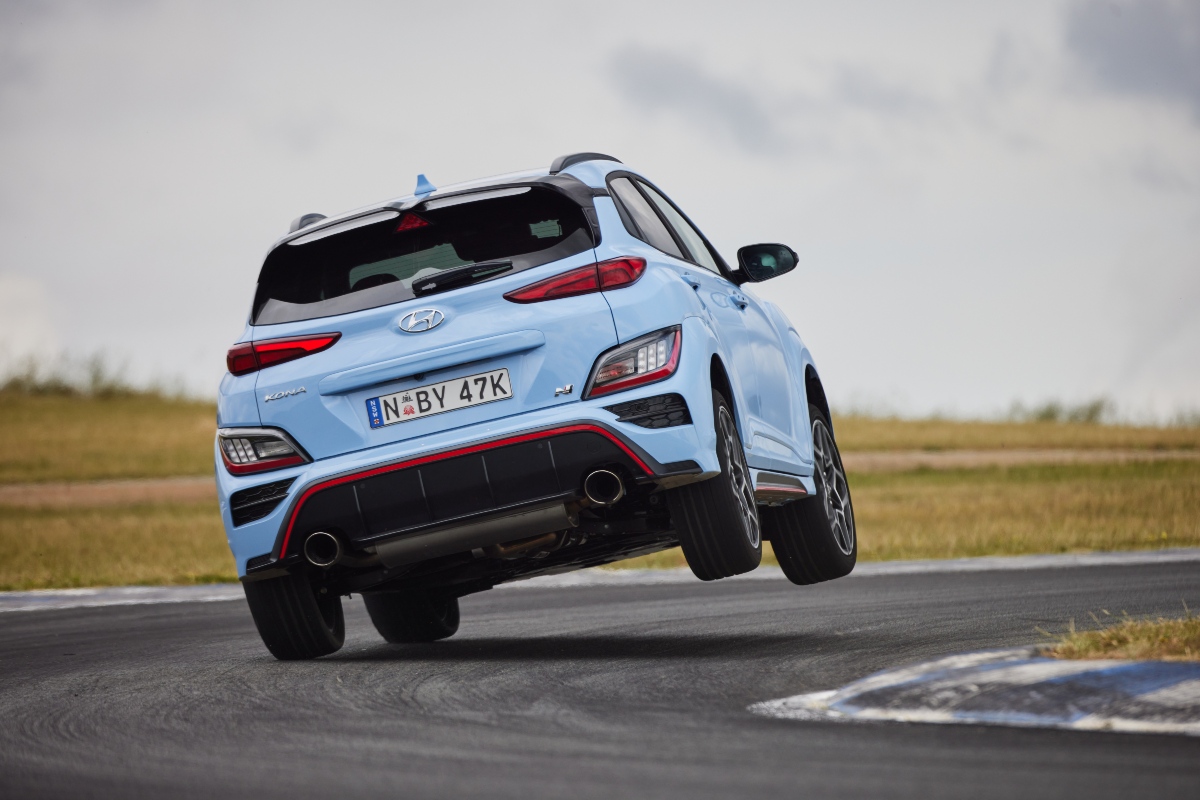
What is it?
The first combination of a hot hatch and SUV, we’ve had plenty of performance SUVs from the likes of Audi, BMW and even Lamborghini, but there’s not been a mainstream model like this before.
Volkswagen has dabbled with the Tiguan 162 TSI R-Line, but the Hyundai Kona N is the first compact SUV to get the same treatment as a hot hatch. And when I say the ‘same’ I mean it, this is packing the same running gear as the i30 N. That means the same turbocharged engine, same dual-clutch transmission and the same track-tuned suspension as the South Korean brand’s acclaimed hot hatch.
ROAD TEST: 2021 Hyundai i30 N review
Having finally landed in Australia we’re able to take it for an extended road drive to find out if this is going to be a new trendsetter or just another genre-blurring bust.
Does it have any racing pedigree?
The South Korean brand is keen to stress the connection between its motorsport and road car programs and while it’s unlikely we’ll see a Kona in TCR or WRC anytime soon it’s clear that this is an SUV built with the racetrack in mind.

Given it shares much of its mechanical DNA with the i30 N, it’s likely that Hyundai has been able to transfer some of the same knowledge between the i30 N road and race car.
What’s under the bonnet?
As mentioned earlier, it gets the same 2.0-litre four-cylinder turbocharged petrol engine as the i30 N. This is an updated version of what was in the original i30 N, so lessons learnt on that first performance car for the brand have been applied to this.

Specifically that means what Hyundai calls its “flat-power tune” which has been designed to deliver the performance across a broader rev range. It means that the 206kW of power hits between 5000-6000rpm and the 392Nm of torque is available from 2100-4700rpm.
The engine is paired to the new eight-speed dual-clutch transmission that debuted in the facelifted i30 N (branded as N-DCT); the six-speed manual from the hatch isn’t offered in the Kona N. The introduction of the new transmission is a big deal for Hyundai because it opens up the market for these types of cars in Australia to a much broader audience.
While it’s the same gearbox found in other Hyundai models, such as the Sonata N-Line, for the Kona N (and i30 N) it features three unique modes – N Grin Shift, N Power Shift and N Track Sense Shift.
N Grin Shift increases torque by allowing the turbocharger to overboost for a short burst (roughly 20 seconds); N Power Shift provides faster shifts on track; and N Track Sense Shift is effectively a sports mode for the transmission, allowing it to hold gears and be more aggressive when conditions suit.
And if all that is too confusing, you can simply slot the gear lever into manual mode and use the paddles on the back of the steering wheel.
While the Kona is available with all-wheel drive in other models, the N version sends its power to the front wheels only, through an electronically-controlled mechanical limited slip differential (e-LSD), which has two settings (Normal and Sport).
Not surprisingly then the Kona N feels just as rapid on the road as the i30 N, with the same punch out of corners. The new flat-tune was a noticeable improvement in the i30 N and it embunes the Kona N with a strong mid-range that helps it feel strong corner to corner.
How does it handle?
Even though it has similar underpinnings to the i30 N it has a noticeably different character on the road. It’s an obvious statement, but the Kona N feels so much taller than a traditional hot hatch from the moment you get in.

This is because Hyundai’s N division made a clear decision to retain the extra ride height of the Kona, instead of lowering and stiffening the suspension too much, even if it meant sacrificing performance because they wanted to retain the high-riding appeal of an SUV.
While it means the Kona N doesn’t feel quite as sharp on the road as the i30 N, it still feels tuned for performance and, just as importantly, has its own unique personality to create a point-of-difference between the two otherwise similar models.
Given its extra height it does lean a lot more in corners than the i30, which takes some getting used to, but once you do you’re pleasantly surprised to find that it hangs on well in the bends.
Combined with direct and responsive steering and strong brakes, the Kona N manages to pack genuine hot hatch thrills into an SUV body.
Where would you most like to drive it?
A racetrack seems the obvious answer, given Hyundai’s confidence in its performance. While we were fortunate enough to take the Kona N to Wakefield Park for some track laps, we’ll publish a separate Track Test in the near future.

Instead, the Kona N feels like it was built for weekend road trips across the twisty roads that litter Australia’s regional areas. It would feel at home in the Victorian High Country or the Great Ocean Road.
What’s the interior like?
It looks like just what you’d expect to find in a high-quality hot hatch. There’s sports seats with dark trim and contrasting ‘Performance Blue’ stitching, a sports steering wheel and other sporty touches.

There are some other nice touches, like the blue highlights in the air-con vents and the blue stitching throughout the cabin. The biggest giveaway that you’re in the most potent Kona though is the steering wheel, which has two blue ‘N’ programmable buttons and a bright red one for the ‘N Grin Shift’ feature.
In terms of space, the Kona N isn’t much larger than the i30 N in practical terms, but it offers reasonable room front and rear for adults.
Is it good value for money?
Hyundai is offering two different versions of the Kona N – standard and Premium. The range begins at $47,500 (plus on-road costs) for the standard model, while the Kona N Premium starts at $50,500.

The car is well-equipped with all the performance extras plus loads of active safety equipment as well as goodies such as navigation, digital radio, Apple CarPlay/Android Auto and a Harman Kardon sound system. Stepping up to the Premium model adds some luxuries like suede and leather interior trim, a sunroof, heated and ventilated seats and a head-up display.
Given it has no obvious rivals at the moment it’s hard to put its value into context, but with so many shared elements with the i30 N – which is priced from $47,500 for its N-DCT equipped version – you’re not actually paying an extra to get the SUV body.
Would I buy one?
So I asked at the start if the Kona N is the sign of things to come or a step too far for SUVs? The answer is it looks like the former, with would-be rivals set to emerge in the coming years. Volkswagen will launch the T-Roc R and Tiguan R in 2022 and will introduce the Spanish Cupra brand with the Formentor and Ateca hi-po high-riders.

In the meantime, Hyundai has the market to itself and the Kona N should certainly have plenty of appeal. It manages to combine the seemingly opposite traits of hot hatch performance and SUV practicality into not only a cohesive package, but an engaging one.
2021 Hyundai Kona N price and specifications
| Price: | From $47,500 plus on-road costs |
| Engine: | 2.0-litre four-cylinder turbo petrol |
| Power: | 206kW at 5500-6000rpm |
| Torque: | 392Nm at 2100-4700rpm |
| Transmission: | Eight-speed dual-clutch auto, front-wheel drive |
| Fuel use: | 9.0L/100km |
| Wheels: | 19-inch alloys |
| Tyres: | 235/40 R19 |
| Length: | 4215mm |
| Width: | 1800mm |
| Height: | 1550mm |
| Weight: | 1569kg |
| 0-100km/h: | 5.5 seconds (claimed) |













Discussion about this post